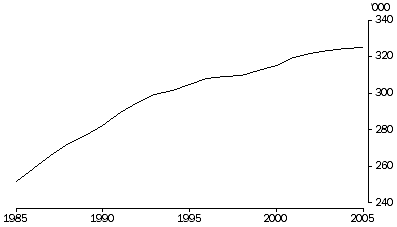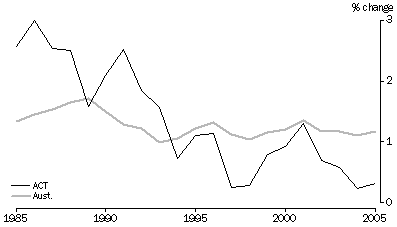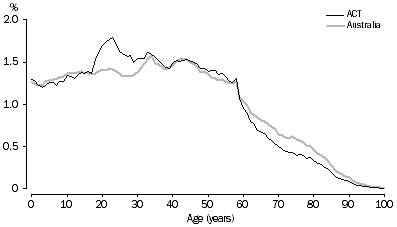|
TOTAL POPULATION
The estimated resident population of the Australian Capital Territory (ACT) at 30 June 2005 was 325,200 people, an increase of 1,000 from June 2004.
POPULATION OF THE AUSTRALIAN CAPITAL TERRITORY, 30 June

The ACT's population grew by 0.3% between June 2004 and June 2005, slightly more than the previous year (0.2%). Australia's growth rate between June 2004 and June 2005 was 1.2%. At June 2005 the population of the ACT made up 1.6% of Australia's population.
North Canberra Statistical Subdivision (SSD) recorded the largest growth of all SSDs in the ACT for the year ending 30 June 2005, up 860 people (or 2.1%). Gungahlin-Hall SSD increased by 750 people (2.5%) and South Canberra SSD by 550 people (2.3%). Weston Creek-Stromlo SSD recorded little change, while Tuggeranong SSD decreased by 770 people, Belconnen SSD by 190 people and Woden Valley SSD by 170 people.
Of Statistical Local Areas (SLAs) in the ACT, Gungahlin-Hall - SSD Bal (which includes the suburbs of Gungahlin Town Centre and Harrison) recorded the largest increase, up 780 people, followed by Turner (up 350 people) and Barton (up 310 people).
ANNUAL POPULATION CHANGE, 30 June

AGE AND SEX STRUCTURE
At June 2005 there were 98.0 males for every 100 females in the ACT, compared to 99.0 males for every 100 females in Australia.
The population of the ACT is younger than the total Australian population. At June 2005, the median age of the ACT population (the age at which half the population is older and half is younger) was 34.5 years, compared to a national median age of 36.6 years.
Within the ACT, the SSD of Gungahlin-Hall had the youngest population at June 2005, with median age of 31.1 years. This was followed by Tuggeranong and North Canberra, with median ages of 33.1 and 33.3 years respectively, and Belconnen (34.0 years). Weston Creek-Stromlo (40.3 years), Woden Valley (40.1 years) and South Canberra (38.5 years) had the highest median ages.
In general, the ACT has lower proportions of people at all ages over 59 years than Australia, but higher proportions of people aged between 16 and 58 years. The proportion of young adults (aged between 18 to 33 years) in the ACT is particularly high compared to Australia, reflecting the number of people of these ages who move to Canberra for the purposes of tertiary education or employment.
AGE DISTRIBUTION - ACT and Australia, 2005

Population under 15 years
There were 62,400 people aged under 15 years in the ACT at June 2005, making up 19.2% of the population. Nearly one-quarter of the populations of both Gungahlin-Hall SSD (23.9%) and Tuggeranong SSD (23.6%) were aged under 15 years. The SLAs with the highest proportion of population under 15 years were the Tuggeranong suburbs of Conder (31.1%) and Banks (29.1%). North Canberra SSD had the lowest proportion of people aged under 15 years at 13.5%, with Acton having only 1.7%.
Population 15 to 24 years
There were 51,900 people aged 15 to 24 years in the ACT at June 2005, making up 16.0% of the population. The highest proportion of people in this age group was in North Canberra SSD (20.3%). The SLAs with the highest proportion of people aged 15 to 24 were those with large student populations; in particular Acton (77.7%), with the Australian National University, Duntroon (65.1%), with the Australian Defence Force Academy, Bruce (39.8%), with the University of Canberra, and Belconnen Town Centre (34.8%).
Population 65 years and over
There were 31,300 people aged 65 years and over in the ACT at June 2005, making up 9.6% of the population. The highest proportions of people aged 65 years and over were in the SSDs of Woden Valley (15.9%), South Canberra (15.0%) and Weston Creek-Stromlo (12.6%). Almost one quarter (24.6%) of the population of Deakin in South Canberra SSD were aged 65 years and over.
POPULATION AGEING
Consistent with the national trend, the population of the ACT is continuing to age. The median age of the ACT population (34.5 years in 2005) has increased 0.3 years since 2004, 3.5 years since 1995 and 6.4 years since 1985. By comparison the median age of the Australian population has increased 5.9 years since 1985.
Over the last three decades the ACT has experienced a steady decline in the proportion of the population aged under 15 years and a steady increase in the proportion aged 65 years and over. Since 1995 the number of children aged under 15 years has decreased by 8.0% (from 67,800 to 62,400), the population aged 65 years and over has increased by 45.5% (from 21,500 to 31,300), and the population aged 85 years and over has more than doubled (from 1,500 to 3,300). |
 Print Page
Print Page
 Print All
Print All